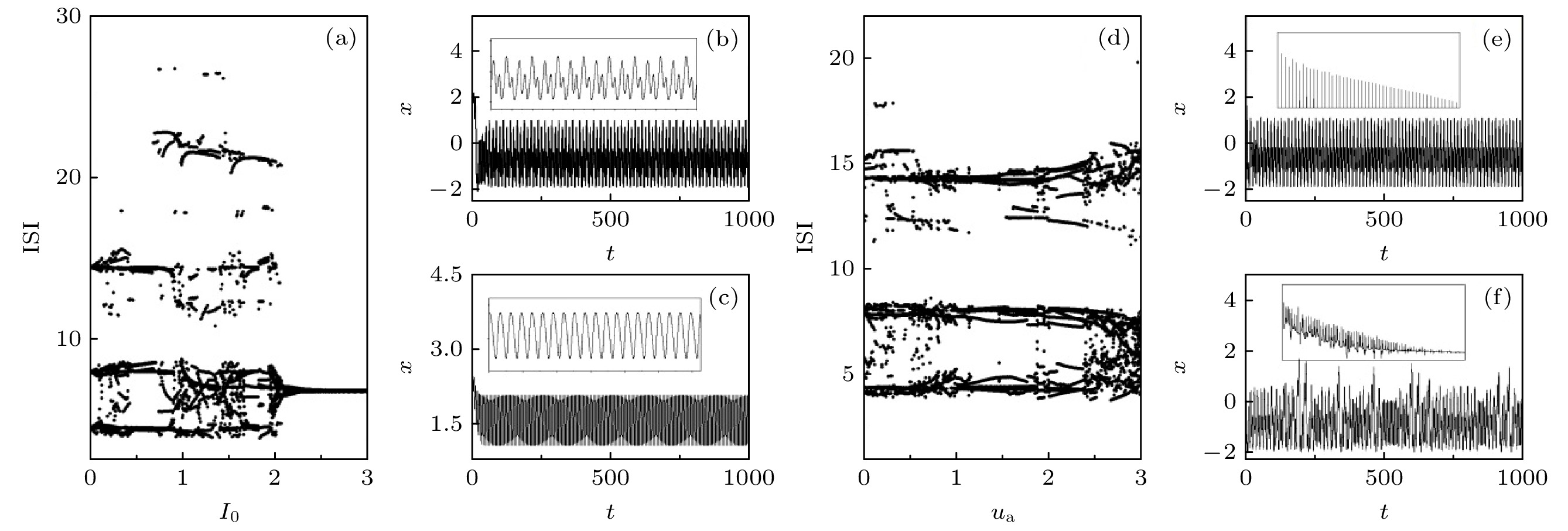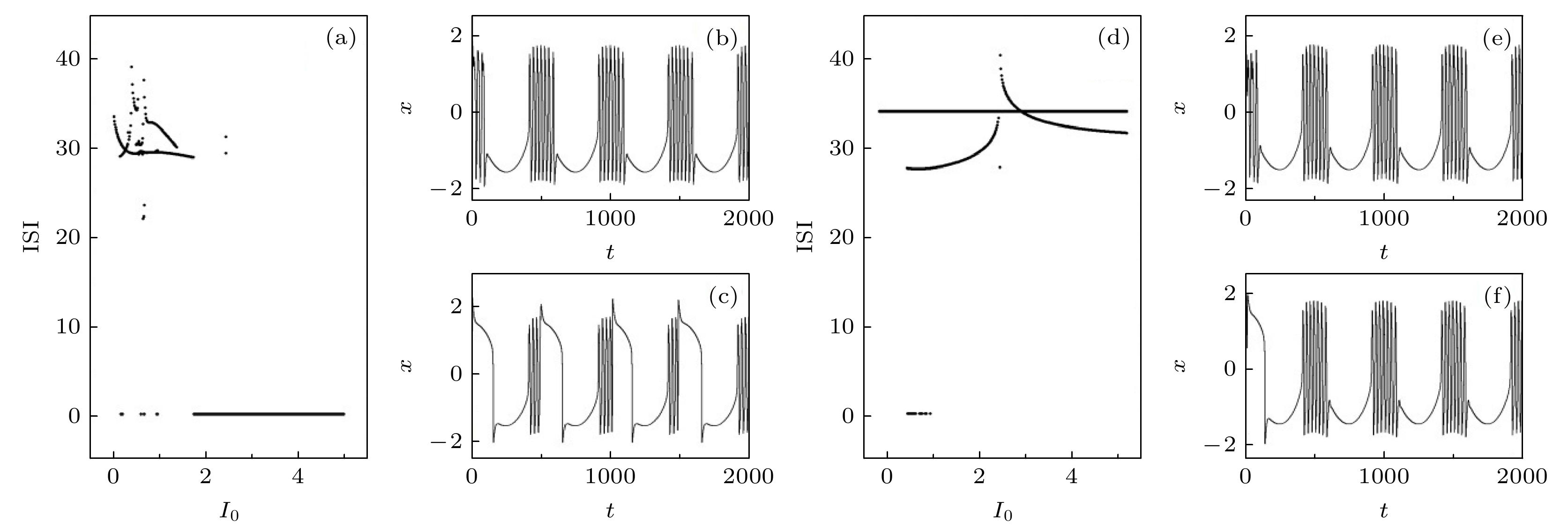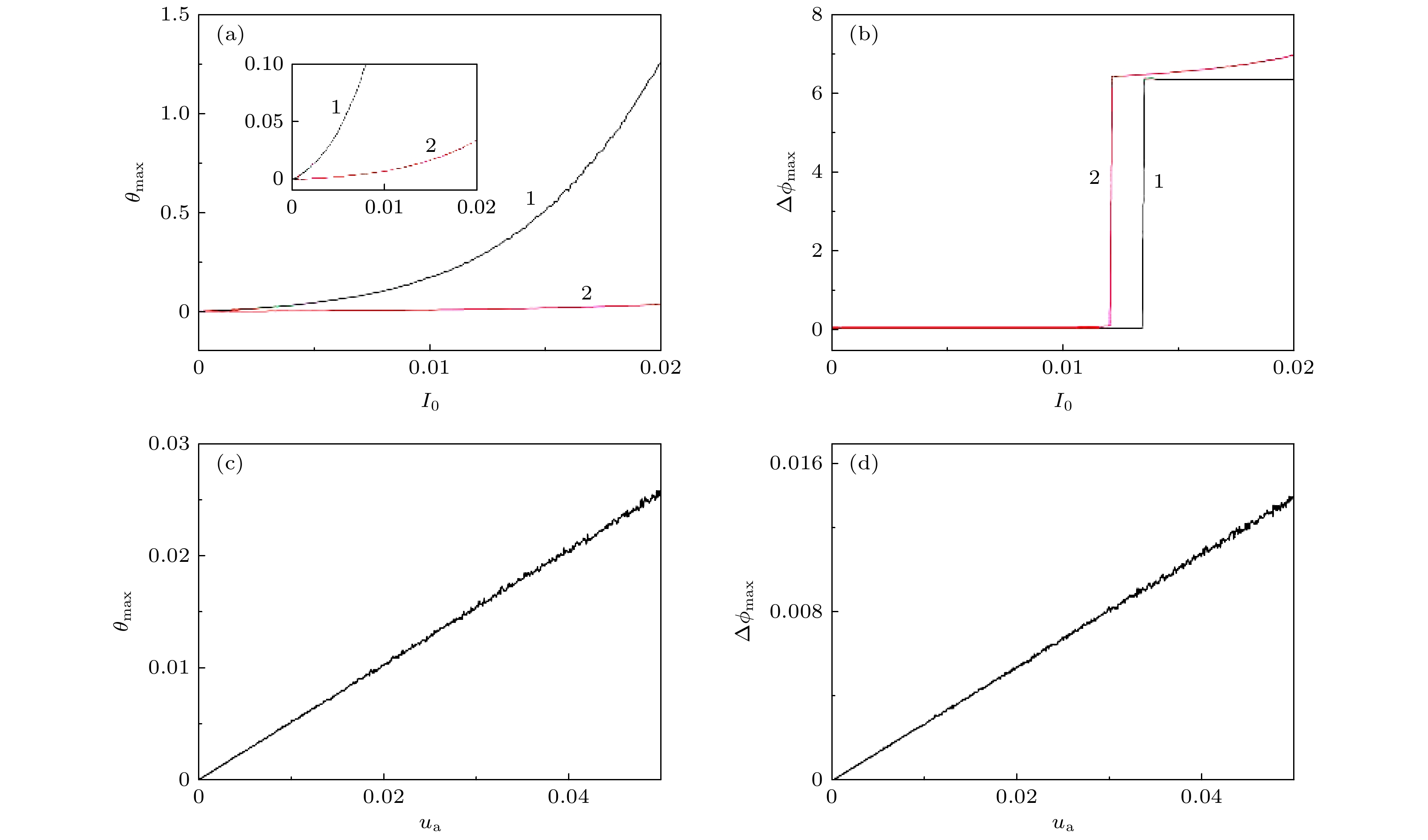-
The photoreceptors can receive all kinds of visible light which is translated to the bioelectrical signal for the visual cortex. The function would be simulated by the photoelectric effect. This paper studies the dynamic characteristics of FitzHugh-Nagumo neurons coupled with a phototube. In the parameter space of phototube, the synchronization region of the coupled system in which the neuron mode is in chaos and burst, is discussed in detail; the data show that the forced resonance is prominent in the complete synchronization of the system when the coupling strength is low, while the phase synchronization is observed in numerical experiment when the coupling strength is strong. The active operation of the phototube, as well the inverse cutoff voltage can modulate the synchronization of the system. Our work can be used to understand the mechanism of the retinal diseases, such as macular degeneration.
-
Keywords:
- neuron /
- phototube /
- synchronization /
- phase lock
[1] Ma J, Song X, Jin W, Wang C 2015 Chaos, Solitons Fractals 80 31
 Google Scholar
Google Scholar
[2] Iqbal M, Rehan M, Hong K S 2017 Plos One 12 e0176986
 Google Scholar
Google Scholar
[3] Sotero R C, Trujillo-Barreto N J 2008 Neuroimage 39 290
 Google Scholar
Google Scholar
[4] Izhikevich E M 2004 IEEE Trans. Neural Networks 15 1063
 Google Scholar
Google Scholar
[5] Ibarz B, Casado J M, Sanjuán M A F 2011 Phys. Rep. 501 1
 Google Scholar
Google Scholar
[6] Hodgkin A L, Huxley A F 1990 Bull. Math. Biol. 52 25
 Google Scholar
Google Scholar
[7] Fitzhugh R 1961 Biophys. J. 1 445
 Google Scholar
Google Scholar
[8] Shilnikov A 2012 Nonlinear Dyn. 68 305
 Google Scholar
Google Scholar
[9] Miesenbock G, Kevrekidis I G 2005 Annu. Rev. Neurosci. 28 533
 Google Scholar
Google Scholar
[10] Gu H, Pan B 2015 Nonlinear Dyn. 81 2107
 Google Scholar
Google Scholar
[11] Pikovskii A, Rabinovich M 1978 Dokl. Akad. Nauk SSSR 239 301
[12] Lv M, Wang C, Ren G, Ma J, Song X 2016 Nonlinear Dyn. 85 1479
 Google Scholar
Google Scholar
[13] Baines P G 2008 Prog. Phys. Geogr. 32 475
 Google Scholar
Google Scholar
[14] Zhang X, Wang C, Ma J, Ren G 2020 Mod. Phys. Lett. B 2050267
 Google Scholar
Google Scholar
[15] Zhang G, Ma J, Alsaedi A, Ahmad B, Alzahrani F 2018 Appl. Math. Comput. 321 290
 Google Scholar
Google Scholar
[16] Yao Z, Ma J, Yao Y, Wang C 2019 Nonlinear Dyn. 96 205
 Google Scholar
Google Scholar
[17] Xu Y M, Yao Z, Hobiny A, Ma J 2019 Front. Inform. Tech. El. 20 571
 Google Scholar
Google Scholar
[18] Liu Z, Wang C, Jin W, Ma J 2019 Nonlinear Dyn. 97 2661
 Google Scholar
Google Scholar
[19] Tosini G, Doyle S, Geusz M, Menaker M 2000 Proc. Natl. Acad. Sci. 97 11540
 Google Scholar
Google Scholar
[20] Menaker M 1972 Sci. Am. 226 22
 Google Scholar
Google Scholar
[21] Kennedy D 1958 Am. J. Ophthal. 46 19
 Google Scholar
Google Scholar
[22] Martenson M E, Halawa O I, Tonsfeldt K J, et al. 2016 Pain 157 868
 Google Scholar
Google Scholar
[23] Liu Y, Xu W J, Ma J, Alzahrani F, Hobiny A 2020 Front. Inform. Tech. El. 21 1387
 Google Scholar
Google Scholar
[24] Li J R, Wang J P, Jiang L 1994 Biosens. Bioelectron. 9 147
 Google Scholar
Google Scholar
[25] Zou W, Senthilkumar D V, Zhan M, Kurths J 2013 Phys. Rev. Lett. 111 014101
 Google Scholar
Google Scholar
[26] Wu Y, Xiao J, Hu G, Zhan M 2012 EPL 97 40005
 Google Scholar
Google Scholar
[27] Perc M 2009 Biophys. Chem. 141 175
 Google Scholar
Google Scholar
[28] Lin W, Wang Y, Ying H, Lai Y C, Wang X 2015 Phys. Rev. E 92 012912
 Google Scholar
Google Scholar
[29] 张平伟, 唐国宁, 罗晓曙 2005 物理学报 54 3497
 Google Scholar
Google Scholar
Zhang P W, Tang G N, Luo X S 2005 Acta Phys. Sin. 54 3497
 Google Scholar
Google Scholar
[30] Wouapi K M, Fotsin B H, Louodop F P, Feudjio K F, Njitacke Z T, Djeudjo T H 2020 Cogn. Neurodyn. 14 375
 Google Scholar
Google Scholar
[31] Shafiei M, Jafari S, Parastesh F, Ozer M, Kapitaniak T, Perc M 2020 Commun. Nonlinear Sci. Numer. Simul. 84 105175
 Google Scholar
Google Scholar
[32] Phan C, You Y 2020 Nonlinear. Anal.-Real 55 103139
 Google Scholar
Google Scholar
[33] Moayeri M M, Rad J A, Parand K 2020 Comput. Math. Appl. 80 1887
 Google Scholar
Google Scholar
[34] Makovkin S Y, Shkerin I V, Gordleeva S Y, Ivanchenko M V 2020 Chaos, Solitons Fractals 138 109951
 Google Scholar
Google Scholar
[35] Zou Y L, Zhu J, Chen G, Luo X S 2005 Chaos, Solitons Fractals 25 1245
 Google Scholar
Google Scholar
[36] Zhou S, Hong Y, Yang Y, Lü L, Li C 2020 Pramana J. Phys. 94 34
 Google Scholar
Google Scholar
[37] Venkatesh P, Venkatesan A, Lakshmanan M 2016 Pramana J. Phys. 86 1195
 Google Scholar
Google Scholar
[38] Sivaganesh G, Sweetlin M D, Arulgnanam A 2016 J. Korean Phys. Soc. 69 124
 Google Scholar
Google Scholar
[39] Binczak S, Jacquir S, Bilbault J M, Kazantsev V B, Nekorkin V I 2006 Neural Networks 19 684
 Google Scholar
Google Scholar
[40] Wade J J, Mcdaid L J, Harkin J, Crunelli V, Kelso J S 2011 PloS One 6 e29445
 Google Scholar
Google Scholar
[41] Sambas A, WS M S, Mamat M 2015 J. Eng. Sci. Tech. Rev. 8 89
 Google Scholar
Google Scholar
[42] Daoudal G, Hanada Y, Debanne D 2002 PNAS 99 14512
 Google Scholar
Google Scholar
[43] Chorev E, Brecht M 2012 J. Neurophysiol. 108 1584
 Google Scholar
Google Scholar
[44] 杨永霞, 李玉叶, 古光华 2020 物理学报 69 040501
 Google Scholar
Google Scholar
Yhang Y X, Li Y Y, Gu G H 2020 Acta Phys. Sin. 69 040501
 Google Scholar
Google Scholar
[45] 汪芃, 李倩昀, 唐国宁 2018 物理学报 67 030502
 Google Scholar
Google Scholar
Wang P, Li Q Y, Tang G N 2018 Acta Phys. Sin. 67 030502
 Google Scholar
Google Scholar
[46] FitzHugh R 1955 Bull. Math. Biophys. 17 257
 Google Scholar
Google Scholar
[47] Nagumo J, Arimoto S, Yoshizawa S 1962 Proc. IRE 50 2061
 Google Scholar
Google Scholar
[48] Kawato M, Suzuki R 1980 J. Theor. Biol. 86 547
 Google Scholar
Google Scholar
[49] Okuda M 1981 Prog. Theor. Phys. 66 90
 Google Scholar
Google Scholar
[50] Treutlein H, Schulten K 1985 Ber. Bunse. Ges. Phys. Chem. 89 710
 Google Scholar
Google Scholar
[51] Rajasekar S, Lakshmanan M 1988 J. Theor. Biol. 133 473
 Google Scholar
Google Scholar
[52] Einstein A 1905 Ann. Physik. 17 132
-
图 5 耦合系统中神经元的ISI和放电序列(f = 0.16) (a) ua = 0.1; (b) I0 = 1.5, ua = 0.1; (c) I0 = 2.5, ua = 0.1; (d) I0 = 0.3; (e) ua = 1.5, I0 = 0.3; (f) ua = 2.3, I0 = 0.3
Fig. 5. ISI and the firing sequence of neuron in the coupled system (f = 0.16): (a) ua = 0.1; (b) I0 = 1.5, ua = 0.1; (c) I0 = 2.5, ua = 0.1; (d) I0 = 0.3; (e) ua = 1.5, I0 = 0.3; (f) ua = 2.5, I0 = 0.3.
图 9 耦合系统中神经元的ISI和放电序列(f = 0.002) (a) ua = 0.01; (b) I0 = 0.5, ua = 0.01; (c) I0 = 1.5, ua = 0.01; (d) I0 = 0.3; (e) ua = 0.5, I0 = 0.3; (f) ua = 1.5, I0 = 0.3
Fig. 9. ISI and the firing sequence of neuron in the coupled system (f = 0.002): (a) ua = 0.01; (b) I0 = 0.5, ua = 0.1; (c) I0 = 1.5, ua = 0.1; (d) I0 = 0.3; (e) ua = 0.5, I0 = 0.3; (f) ua = 1.5, I0 = 0.3.
图 11 最大误差函数和最大相位差随参数的变化(灰色曲线为(6)式中的非线性耦合, 红色曲线为线性耦合) (a), (b) ua = 0.01; (c), (d) I0 = 0.001
Fig. 11. The maximum error function and the maximum phase difference change with the parameters, the grey curve represents the nonlinear coupling in Eq. (6) and the red curve is the linear one: (a), (b) ua = 0.01; (c), (d) I0 = 0.001.
图 12 系统误差、相位差和光电管功率随时间的演化(ua = 0.01) (a), (e), (i) I0 = 0.001; (b), (f), (j) I0 = 0.01; (c), (g), (k) I0 = 0.013; (d), (h), (l) I0 = 0.014
Fig. 12. Evolution of error function, phase error and phototube power (ua = 0.01): (a), (e), (i) I0 = 0.001; (b), (f), (j) I0 = 0.01; (c), (g), (k) I0 = 0.013; (d), (h), (l) I0 = 0.014.
表 1 不同外界刺激频率下的耦合FHN神经元分类
Table 1. Category of the coupled FHN neurons driven by external stimulation with different frequencies.
频率f 0.16 0.002 0.012 0.06 放电状态 混沌放电 簇放电 尖峰放电 周期放电 反向截止电压ua 0.1 0.5 0.01 0.5 0.01 0.5 0.01 0.5 耦合分类 case 1 case 2 case 3 case 4 case 5 case 6 case 7 case 8 -
[1] Ma J, Song X, Jin W, Wang C 2015 Chaos, Solitons Fractals 80 31
 Google Scholar
Google Scholar
[2] Iqbal M, Rehan M, Hong K S 2017 Plos One 12 e0176986
 Google Scholar
Google Scholar
[3] Sotero R C, Trujillo-Barreto N J 2008 Neuroimage 39 290
 Google Scholar
Google Scholar
[4] Izhikevich E M 2004 IEEE Trans. Neural Networks 15 1063
 Google Scholar
Google Scholar
[5] Ibarz B, Casado J M, Sanjuán M A F 2011 Phys. Rep. 501 1
 Google Scholar
Google Scholar
[6] Hodgkin A L, Huxley A F 1990 Bull. Math. Biol. 52 25
 Google Scholar
Google Scholar
[7] Fitzhugh R 1961 Biophys. J. 1 445
 Google Scholar
Google Scholar
[8] Shilnikov A 2012 Nonlinear Dyn. 68 305
 Google Scholar
Google Scholar
[9] Miesenbock G, Kevrekidis I G 2005 Annu. Rev. Neurosci. 28 533
 Google Scholar
Google Scholar
[10] Gu H, Pan B 2015 Nonlinear Dyn. 81 2107
 Google Scholar
Google Scholar
[11] Pikovskii A, Rabinovich M 1978 Dokl. Akad. Nauk SSSR 239 301
[12] Lv M, Wang C, Ren G, Ma J, Song X 2016 Nonlinear Dyn. 85 1479
 Google Scholar
Google Scholar
[13] Baines P G 2008 Prog. Phys. Geogr. 32 475
 Google Scholar
Google Scholar
[14] Zhang X, Wang C, Ma J, Ren G 2020 Mod. Phys. Lett. B 2050267
 Google Scholar
Google Scholar
[15] Zhang G, Ma J, Alsaedi A, Ahmad B, Alzahrani F 2018 Appl. Math. Comput. 321 290
 Google Scholar
Google Scholar
[16] Yao Z, Ma J, Yao Y, Wang C 2019 Nonlinear Dyn. 96 205
 Google Scholar
Google Scholar
[17] Xu Y M, Yao Z, Hobiny A, Ma J 2019 Front. Inform. Tech. El. 20 571
 Google Scholar
Google Scholar
[18] Liu Z, Wang C, Jin W, Ma J 2019 Nonlinear Dyn. 97 2661
 Google Scholar
Google Scholar
[19] Tosini G, Doyle S, Geusz M, Menaker M 2000 Proc. Natl. Acad. Sci. 97 11540
 Google Scholar
Google Scholar
[20] Menaker M 1972 Sci. Am. 226 22
 Google Scholar
Google Scholar
[21] Kennedy D 1958 Am. J. Ophthal. 46 19
 Google Scholar
Google Scholar
[22] Martenson M E, Halawa O I, Tonsfeldt K J, et al. 2016 Pain 157 868
 Google Scholar
Google Scholar
[23] Liu Y, Xu W J, Ma J, Alzahrani F, Hobiny A 2020 Front. Inform. Tech. El. 21 1387
 Google Scholar
Google Scholar
[24] Li J R, Wang J P, Jiang L 1994 Biosens. Bioelectron. 9 147
 Google Scholar
Google Scholar
[25] Zou W, Senthilkumar D V, Zhan M, Kurths J 2013 Phys. Rev. Lett. 111 014101
 Google Scholar
Google Scholar
[26] Wu Y, Xiao J, Hu G, Zhan M 2012 EPL 97 40005
 Google Scholar
Google Scholar
[27] Perc M 2009 Biophys. Chem. 141 175
 Google Scholar
Google Scholar
[28] Lin W, Wang Y, Ying H, Lai Y C, Wang X 2015 Phys. Rev. E 92 012912
 Google Scholar
Google Scholar
[29] 张平伟, 唐国宁, 罗晓曙 2005 物理学报 54 3497
 Google Scholar
Google Scholar
Zhang P W, Tang G N, Luo X S 2005 Acta Phys. Sin. 54 3497
 Google Scholar
Google Scholar
[30] Wouapi K M, Fotsin B H, Louodop F P, Feudjio K F, Njitacke Z T, Djeudjo T H 2020 Cogn. Neurodyn. 14 375
 Google Scholar
Google Scholar
[31] Shafiei M, Jafari S, Parastesh F, Ozer M, Kapitaniak T, Perc M 2020 Commun. Nonlinear Sci. Numer. Simul. 84 105175
 Google Scholar
Google Scholar
[32] Phan C, You Y 2020 Nonlinear. Anal.-Real 55 103139
 Google Scholar
Google Scholar
[33] Moayeri M M, Rad J A, Parand K 2020 Comput. Math. Appl. 80 1887
 Google Scholar
Google Scholar
[34] Makovkin S Y, Shkerin I V, Gordleeva S Y, Ivanchenko M V 2020 Chaos, Solitons Fractals 138 109951
 Google Scholar
Google Scholar
[35] Zou Y L, Zhu J, Chen G, Luo X S 2005 Chaos, Solitons Fractals 25 1245
 Google Scholar
Google Scholar
[36] Zhou S, Hong Y, Yang Y, Lü L, Li C 2020 Pramana J. Phys. 94 34
 Google Scholar
Google Scholar
[37] Venkatesh P, Venkatesan A, Lakshmanan M 2016 Pramana J. Phys. 86 1195
 Google Scholar
Google Scholar
[38] Sivaganesh G, Sweetlin M D, Arulgnanam A 2016 J. Korean Phys. Soc. 69 124
 Google Scholar
Google Scholar
[39] Binczak S, Jacquir S, Bilbault J M, Kazantsev V B, Nekorkin V I 2006 Neural Networks 19 684
 Google Scholar
Google Scholar
[40] Wade J J, Mcdaid L J, Harkin J, Crunelli V, Kelso J S 2011 PloS One 6 e29445
 Google Scholar
Google Scholar
[41] Sambas A, WS M S, Mamat M 2015 J. Eng. Sci. Tech. Rev. 8 89
 Google Scholar
Google Scholar
[42] Daoudal G, Hanada Y, Debanne D 2002 PNAS 99 14512
 Google Scholar
Google Scholar
[43] Chorev E, Brecht M 2012 J. Neurophysiol. 108 1584
 Google Scholar
Google Scholar
[44] 杨永霞, 李玉叶, 古光华 2020 物理学报 69 040501
 Google Scholar
Google Scholar
Yhang Y X, Li Y Y, Gu G H 2020 Acta Phys. Sin. 69 040501
 Google Scholar
Google Scholar
[45] 汪芃, 李倩昀, 唐国宁 2018 物理学报 67 030502
 Google Scholar
Google Scholar
Wang P, Li Q Y, Tang G N 2018 Acta Phys. Sin. 67 030502
 Google Scholar
Google Scholar
[46] FitzHugh R 1955 Bull. Math. Biophys. 17 257
 Google Scholar
Google Scholar
[47] Nagumo J, Arimoto S, Yoshizawa S 1962 Proc. IRE 50 2061
 Google Scholar
Google Scholar
[48] Kawato M, Suzuki R 1980 J. Theor. Biol. 86 547
 Google Scholar
Google Scholar
[49] Okuda M 1981 Prog. Theor. Phys. 66 90
 Google Scholar
Google Scholar
[50] Treutlein H, Schulten K 1985 Ber. Bunse. Ges. Phys. Chem. 89 710
 Google Scholar
Google Scholar
[51] Rajasekar S, Lakshmanan M 1988 J. Theor. Biol. 133 473
 Google Scholar
Google Scholar
[52] Einstein A 1905 Ann. Physik. 17 132
计量
- 文章访问数: 7242
- PDF下载量: 151
- 被引次数: 0














 下载:
下载:












